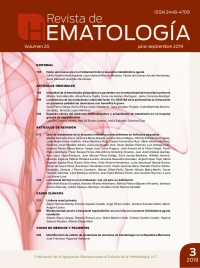Clinical spectrum of antiphospholipid syndrome and current treatment in a second level general hospital.
Rev Hematol Mex. 2019 julio-septiembre;20(3):204-209. https://doi.org/10.24245/rhematol.v20i3.3003
Luis Del Carpio-Orantes,1 Ada Lili Rosas-Lozano,1 Jesús Salvador Sánchez-Díaz2
1 Departamento de Medicina Interna, Hospital General de Zona 71, Delegación Veracruz Norte, Instituto Mexicano del Seguro Social, Veracruz, Ver., México.
2 Unidad de Cuidados Intensivos, Unidad Médica de Alta Especialidad 189, Delegación Veracruz Norte, Instituto Mexicano del Seguro Social, Veracruz, Ver., México.
Resumen
ANTECEDENTES: El síndrome antifosfolipídico es un trastorno autoinmunitario, protrombótico y sistémico que se caracteriza por trombosis arterial, venosa o ambas, pérdida fetal recurrente y títulos persistentemente elevados de anticuerpos antifosfolipídicos.
OBJETIVOS: Identificar las diversas formas de manifestación del síndrome antifosfolipídico y destacar la administración de ribaroxabán como opción terapéutica.
MATERIAL Y MÉTODO: Estudio retrospectivo, longitudinal y descriptivo en el que se analizan los casos de trombosis arterial y venosa asociados con trombofilia tipo síndrome antifosfolipídico ocurridos de 2016 a 2018 en un Hospital de Veracruz.
RESULTADOS: Se encontraron siete pacientes con cuadros trombóticos venosos y arteriales en los que se estudió síndrome antifosfolipídico, el género más afectado fue el femenino y el grupo etario predominante fue el de 21-30 años. El evento trombótico de mayor incidencia fue en el sistema venoso profundo de las extremidades pélvicas en cinco pacientes, en un caso se observó como complicación concomitante con tromboembolia pulmonar y en otro caso infarto cerebral agudo. El síndrome antifosfolipídico fue primario en seis casos y uno asociado con lupus eritematoso sistémico.
CONCLUSIÓN: Se comunica una cohorte de pacientes con diagnóstico establecido de síndrome antifosfolipídico desde una perspectiva de su amplio espectro de manifestación, que va desde una paciente asintomática hasta un síndrome antifosfolipídico catastrófico.
PALABRAS CLAVE: síndrome antifosfolipídico; trombosis; rivaroxabán.
Abstract
BACKGROUND: The antiphospholipid syndrome is an autoimmune, prothrombotic and systemic disorder characterized by arterial and/or venous thrombosis, recurrent fetal loss and persistently elevated antiphospholipid antibody titers.
OBJECTIVES: To identify the various forms of manifestation of antiphospholipid syndrome and to highlight the administration of ribaroxaban as therapeutic option.
MATERIAL AND METHOD: A retrospective, longitudinal and descriptive study in which the cases of arterial and venous thrombosis associated with thrombophilia type antiphospholipid syndrome presented during the period from 2016 to 2018 in a Hospital of Veracruz were analyzed.
RESULTS: We found 7 patients with venous and arterial thrombotic symptoms that were studied antiphospholipid syndrome, the most affected gender was the female and the predominant age group was 21-30 years. The thrombotic event with the highest incidence was in the deep venous system of the pelvic extremities in 5 patients, in one case it was observed as a complication associated with pulmonary thromboembolism and in another case acute cerebral infarction. The antiphospholipid syndrome was primary in 6 cases and one associated with systemic lupus erythematosus.
CONCLUSION: We present a cohort of patients with an established diagnosis of antiphospholipid syndrome from a perspective of its broad spectrum of presentation, ranging from an asymptomatic patient to a catastrophic antiphospholipid syndrome.
KEYWORDS: Antiphospholipid syndrome; Thrombosis; Rivaroxaban.

